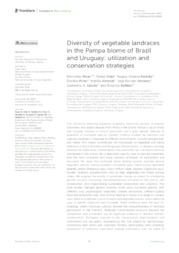Diversity of vegetable landraces in the Pampa biome of Brazil and Uruguay: utilization and conservation strategies.
Diversity of vegetable landraces in the Pampa biome of Brazil and Uruguay: utilization and conservation strategies.
Author(s): RIVAS, M. M.; VIDAL, R.; NEITZKE, R. S.; PRIORI, D.; ALMEIDA, N.; ANTUNES, I. F.; GALVAN; BARBIERI, R. L.
Summary: The historical meeting between originally American people, European colonizers, and slaved peoples from Africa in the biome Pampa in South Brazil and Uruguay involved a cultural syncretism and a great genetic diversity of landraces of cultivated species. Genetic richness evolved by selection and cultural processes in response to different environments, cultural backgrounds, and needs. This review summarized the knowledge on vegetable and maize landraces in South Brazilian and Uruguayan Pampa biome, to design a strategy towards the rediscovery, conservation, and sustainable use. Landraces diversity maintained in situ and ex situ is described, specific case studies are presented, and the main problems and tools towards landraces re-valorization are discussed. We show that traditional family farming systems maintain diverse vegetable species, mainly squashes (Cucurbita spp.), sweet potato (Ipomoea batatas), beans (Phaseolus spp.), onion (Allium cepa), peppers (Capsicum spp.), tomato (Solanum lycopersicum), next to leafy vegetables and maize, among others. We propose the priority of systematic surveys as a basis for monitoring genetic erosion, increasing complementariness between in situ and ex situ conservation, and implementing sustainable conservation and utilization. The case studies highlight genetic diversity within each cultivated species, with different crop physiological responses; disease resistances, different quality traits and associated uses, from animal feeding in maize to a range of culinary uses linked to traditional culture in maize and vegetable species, and ornamental uses of specific Capsicum and Cucurbita. Some landraces were the basis for breeding, where improved cultivars allowed the competitiveness of landrace germplasm in the markets. Renewed industrialized products allowed the competitive and sustainable use of Capsicum landraces in Brazilian farmers communities. Strategies towards in situ conservation improvements and valorization are discussed; emphasizing the role played by agroecology, community seed banks and custodian farmers, participatory plant breeding, promotion of landraces specialties among consumers, and the need of research and capacity building, among others. Farmers’ participation in the decisions is a key factor, along with the academia and the public sector. Landraces and associated knowledge are treasures to be used to benefit from farmers to consumers, directing the course of agriculture towards sustainable directions.
Publication year: 2023
Types of publication: Journal article
Observation
Some of Embrapa's publications are published as ePub files. To read them, use or download one of the following free software options to your computer or mobile device. Android: Google Play Books; IOS: iBooks; Windows and Linux: Calibre.
Access other publications
Access the Agricultural Research Database (BDPA) to consult Embrapa's full library collection and records.
Visit Embrapa Bookstore to purchase books and other publications sold by Embrapa.

